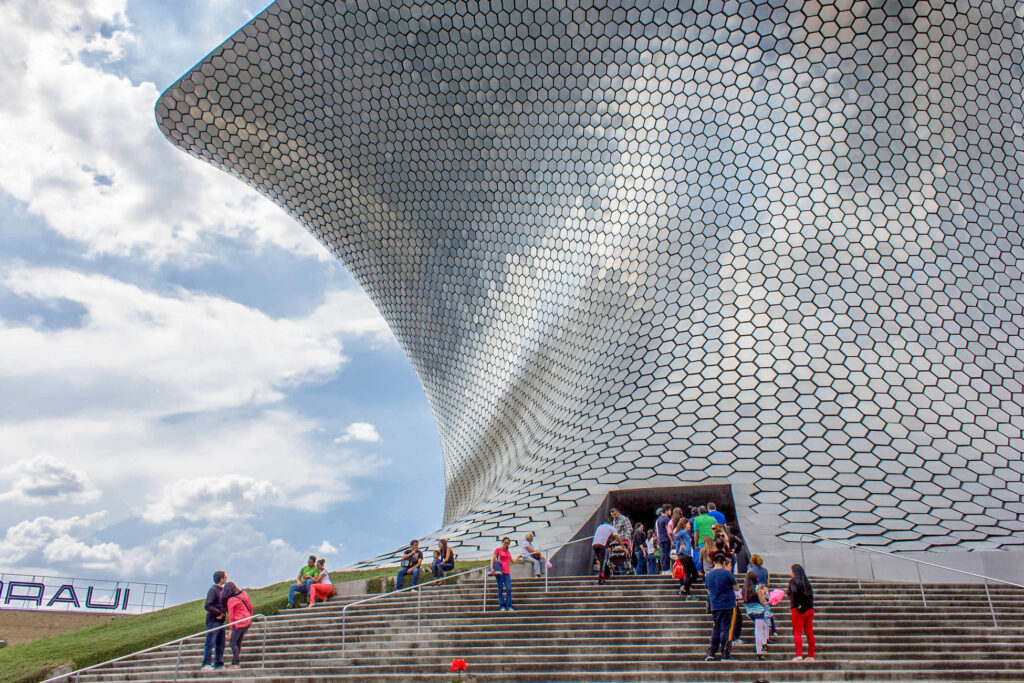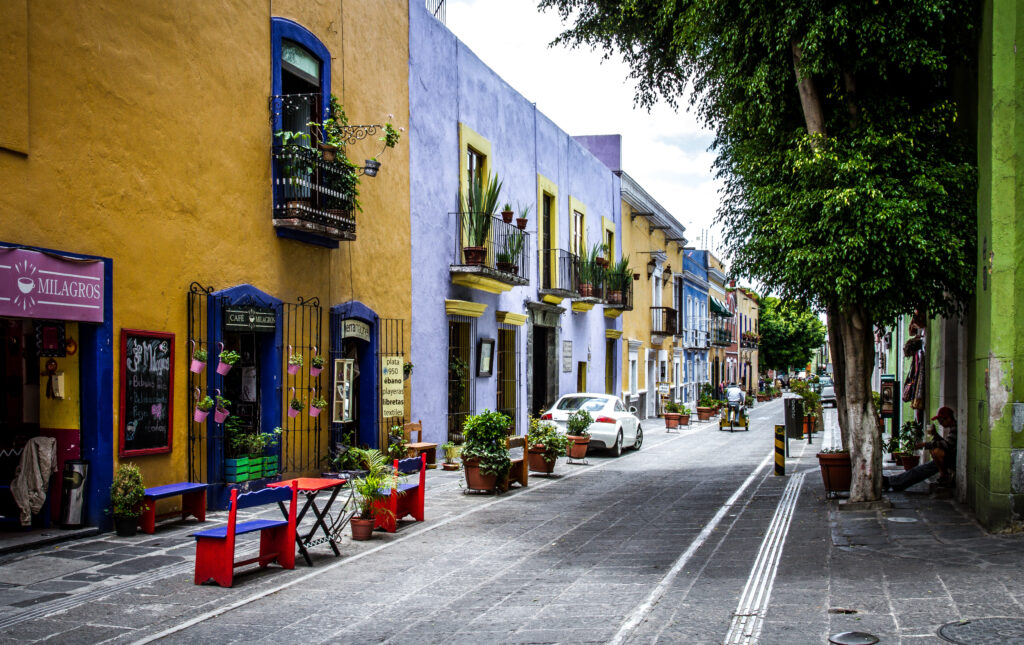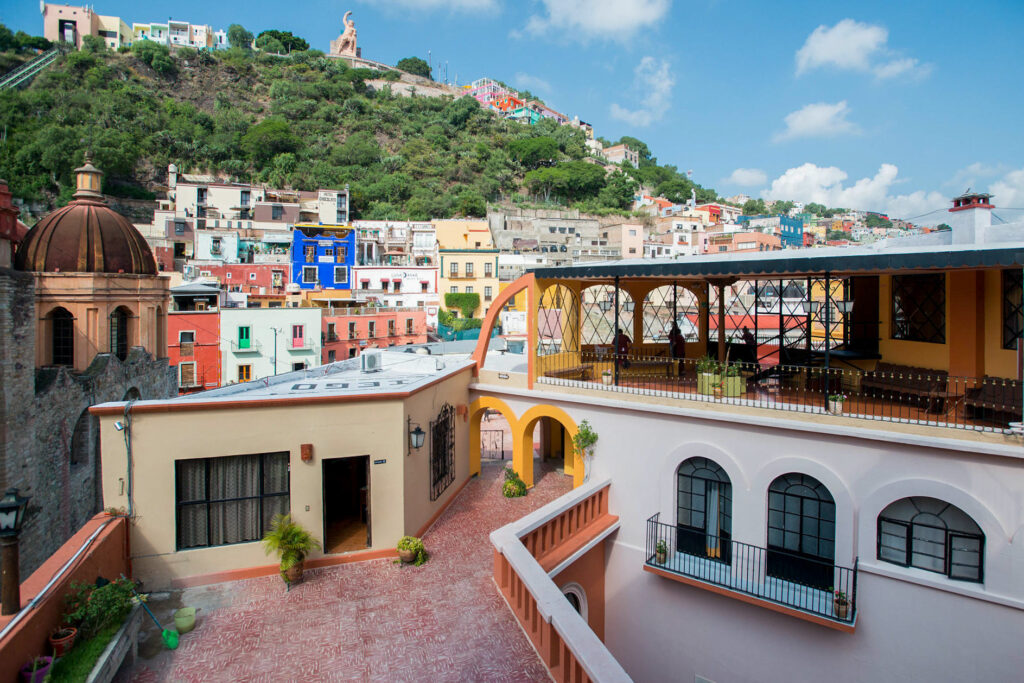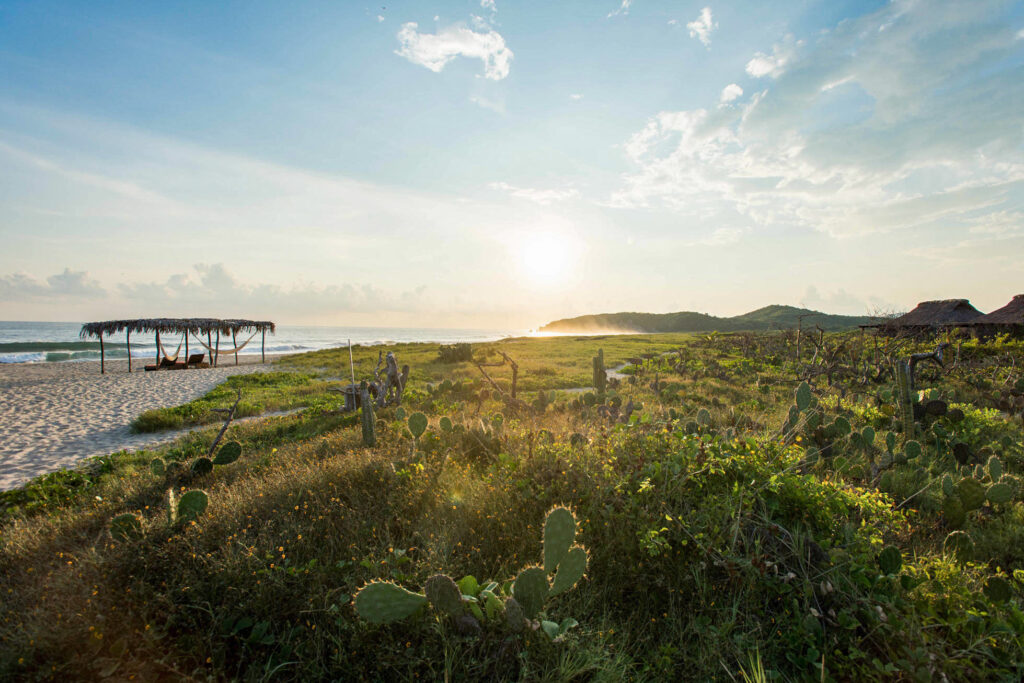While we think it's hard to underrate any destination in Mexico, many travelers regularly overlook some of the coolest destinations found across the country. Yes, we love Tulum and Cancun and Los Cabos — but Mexico has way more to offer than beaches and all-inclusive resorts. From ancient cities to dazzling untouched beaches and amazing foodie destinations, Mexico is packed with hidden gems. Check out the list of underrated destinations before you book your next Mexico vacation, and we guarantee you'll feel like you're in the know.
Editor's Note: Save these Mexican destinations for when it's safe to travel again. Be sure to check the travel rules for visiting Mexico before planning a trip.
If you want to know our favorite under-the-radar beach destination in Mexico, check out our article here.
1. Mexico City: One of the World’s Great Cultural Capitals
Ok — Mexico City isn’t unknown. It’s the largest city in North America, has more museums than any city in the world, and is home to some of the best street food on the planet. It’s also one of the most visited cities in Mexico. However, the majority of American travelers give Mexico City a wide berth and head straight to Mexico’s famous beach destinations. And my oh my—what they are missing.
Where to start? Museums. The space-age Museo Soumaya is just one of the city’s many hubs of culture. You’ll find Frida Kahlo and Diego Rivera’s former house — La Casa Azul (The Blue House, or Museo Frida Kahlo) — in the charming Coyoacan district. There’s also the epic National Museum of Anthropology and the Palacio de Bellas Artes (which hosts live events as well). That’s to say nothing of the famous murals that are found throughout the city — from street art to formal settings like the National Palace and Antiguo Colegio de San Ildefonso, where Rivera, Orozco, and others painted.
Food is stellar everywhere in Mexico City — from holes-in-the-wall like Las Buenas Migas, to internationally famous spots like Pujol. Of course, street food is very much where it’s at in CDMX, and you’ll find stands slinging tortas, tacos, tlayudas, tlacoyos, and nearly every type of regional cuisine on seemingly every other block across the city.
If you’re looking to shop, there’s no shortage of that, either. From the indie boutiques of Roma and Condesa to the more high-end offerings in Polanco, the city is flush with places to drop some pesos on only-in-Mexico souvenirs. You’ll also find history here in spades. The entire Centro Historico is one of the largest preserved colonial zones in the Americas, and has block after block of beautiful architecture. It also holds the ruins of Templo Mayor — the main temple of the Mexican people who populated this region before the Spanish invaded.
And while crime is a rising issue across Mexico, and Mexico City isn’t completely immune, the city’s most touristed neighborhoods (Juarez, Condesa, Roma, and Polanco) are relatively safe. Keep your wits about you when walking around these areas at night, but bar-hopping and heading to the dozens of nightclubs in them is exactly what the locals are doing — and so should you.
Our Mexico City Boutique Hotel Pick: Las Alcobas

Chic and sophisticated (and blissfully quiet in this otherwise noisy city), Las Alcobas has long been our favorite boutique retreat in Mexico City. Situated in posh Polanco, the surrounding neighborhood is incredibly safe and central. Inside, you’ll find an impeccable blend of contemporary and local design, plus perks like a spa and wake up services including fresh coffee.
2. Puebla: Incredible Local Cuisine and Amazing Art
Just a couple hours due east of Mexico City — past the country’s most famous volcanos and some beautiful mountainous terrain — is Puebla. By no means a small town, the capital of Puebla state and its largest city is a bustling, charming place to visit. We recommend spending at least a couple of days here to soak up the cool atmosphere and local culture, as well as giving yourself ample time to see its sights.
You should visit Puebla, if for no other reason than to sample its amazing local cuisine. Mole poblano, tacos al arabe, and cemitas are just a few of the options you’ll find in restaurants and at street stalls throughout the historic Centro and Zocalo. The city and region is also famous for its eye-catching sweets — there’s even a street (known as the Calle de los Dulces) near the Zocalo that’s famous for its abundance of sweet shops. Here you’ll find tortitas de Santa Clara and camotes among the many colorful and edible offerings.
Food aside, Puebla is bursting with culture — both high and low. Atop the highbrow list is Museo Amparo. Situated right in the center of town, this is easily one of the best museums in the Americas. The collection includes cutting-edge contemporary exhibitions alongside an incredible selection of artifacts from the region’s indigenous and ancient cultures, creating a striking juxtaposition. Museo Amparo’s rooftop cafe is a great place for a cup of coffee with a view of Puebla’s baroque cathedral. A bit farther outside of town, you’ll find the actual Baroque Museum (Museo Internacional del Barroco). This straight-from-the-future building holds a mind-bending collection of equally dazzling and over-the-top Baroque artwork. It’s one of the city’s most famous destinations.
After all of that high culture, it’s time to indulge in some guilty pleasures. And there’s no better place to do that in Puebla than at Arena Puebla. Here, you’ll find Mexico’s lucha libre matches in all of their no-frills, dramatic glory. Where Mexico City’s lucha libre arena is all flashing lights and LED screens, Puebla’s wrestling scene feels far more down to earth and all the more thrilling for it. When it’s done, head up the street to grab churros at Puebla La Churreria — you’ll see the line — and tuck into your sweet snack in the busy Zocalo. If there’s not enough in town, couple your time in Puebla with a trip to Cholula, which is less than 30 minutes west and is home to the largest pyramid in Mexico (albeit subterranean), colonial charm, and lovely restaurants (it also has livelier nightlife than Puebla thanks to its university students).
3. Merida: Laid-Back Yucatan Vibes
We’ve already told you how Merida can be an ideal family-friendly alternative to the beach scene of Cancun and the Riviera Maya. Let us tell you why it’s actually one of the best under-the-radar destinations in all of Mexico for any type of traveler. Merida is the cultural capital of western Yucatan, and has an artsy vibe that’s starting to attract a lot of attention. The center of town is packed with colonial relics, many of which have been repurposed for leisure pursuits. Expect a high concentration of boutique hotels, art galleries, shops, cafes, and restaurants along the streets that line the center of town.
The city is more than a blend of Spanish and indigenous cultural roots. The Romanesque cathedral and Casa de Montejo — found on La Plaza Grande, Merida’s main square — are constructed from the ruins of local pyramids, in true cruel Spanish fashion. But there’s also a serious French influence on the town’s layout and style. That’s especially true along beautiful Paseo de Montejo, where huge Beaux Arts mansions line the leafy road. In fact, we recommend hopping on a walking tour to explore the center of Merida and see it all.
More and more these days, Merida — which is safer than other large cities in Mexico — attracts immigrants from Europe and the rest of North America, who come here to start small businesses or involve themselves in the local tourist scene. Art figures largely in Merida, and you’d do well to head the numerous independent galleries in town, including Galeria La Eskalera and Galeria Soho (two of the most popular in town with visitors). If you’re after a more historical glimpse of Merida’s ancient past, check out the Mayan World Museum of Merida.
You’ll need to sample local Yucatecan food while you’re in town. The many upscale restaurants in the city center serve a wide array of cuisines and Mexican-fusion fare. For more traditional options, look for papadzules (which consist of tortillas, eggs, and pipian sauce), pavo relleno negro (shredded turkey bathed in a rich charred chili sauce), and cochinita pibil (a wildly spiced shredded pork). If you need a beach break to unwind, you can head to the laid-back town of Progreso, which is only an hour north of Merida. You’ll also find that the city is well set up for day trips to major archaeological sites like Chichen Itza and Coba, or colonial towns like Valladolid.
Our Merida Hotel Pick: Hotel Casa San Angel

Visitors to Merida are spoiled for choice when it comes to charming boutique hotels, but we can’t help loving Casa San Angel. From its tasty restaurant, plant-filled courtyard, and small plunge pool for cooling off in the tropical heat, there’s a lot to like here. Paseo Montejo is right next to Hotel Casa San Angel, and the rooms are decked out in a mix of colonial and local styles.
4. La Paz: All the Beach Without All of the Cabo
Mexico’s Baja region — consisting of the states of Baja California and Baja California Sur — feels a world away from the rest of Mexico. The area is most famous for cities like Tijuana, the rough-and-tumble border town that’s seeing something of a renaissance, and the Los Cabos region, which draws tens of thousands of resort visitors every year. However, separated as it is from mainland Mexico by the Sea of Cortez, there’s a lot more to Baja than meets the eye. That couldn’t be truer than in La Paz, the capital and largest city in Baja California Sur.
More adventurous travelers are in for a treat in La Paz. Situated about halfway up the coast of the Sea of Cortez from Los Cabos, La Paz is the more authentic alternative to Cabo San Lucas, which can often feel like an American mall was dropped onto the shores of the Sea of Cortez and given one too many tequila shots. La Paz is an altogether different experience. For starters, you won’t find Señor Frogs or anything of the chain kind here. You also won’t find the same level quote-unquote charm that’s on display in Mexico’s more famous colonial towns — though the area around Plaza Constitución is quite lovely.
The city itself is packed with authentic eats, cool bars, and cafes, and walks along the malecon are a great way to find all of those things. A city-sponsored arts program is also dramatically increasing the amount of street art and public murals throughout town, adding a bit of edgy color to what can sometimes be a slightly scruffy town. You’ll find these murals everywhere in the town center. Cuisine in the Baja centers on seafood, though you can expect a healthy dose of fusion and international fare as well, thanks to a fairly sizable immigrant population from other parts of Europe and North America.
La Paz, though, is best for providing a lively (and authentically Mexican) home base to explore the natural wonders of the Baja region. And those wonders are numerous. The most famous destination is actually offshore — Isla Espiritu Santo. This uninhabited island has a few beach campsites for those looking to stay overnight, but otherwise its only residents are sea lions and sea birds — and the numerous underwater species that call its shores home. It’s simple to book tours that depart from La Paz.
The Sea of Cortez is one of the major winter breeding grounds of several whale species from January through March. You can also spot whale sharks in the waters near La Paz from October through May. If you’d prefer to stay on dry land for your beach experience, head to stunning Balandra Beach, where the desert landscape meets the sea in a scene of white sand, turquoise water, and rugged mountains. A car rental is highly recommended so that you can explore the Baja California Sur region from La Paz.
Our La Paz Resort Pick: CostaBaja Resort & Spa
If you’re after a Cabo-style resort experience in a far less Cabo place, check out the CostaBaja Resort & Spa. Multiple pools, a professional golf course, and beautiful contemporary architecture all make this a winner in our book. You’re also right next to the sea if you’d like to get your beach fix.
5. Guanajuato: Colonial Charm and a Buzzing Local Scene
While not everyone has heard of San Miguel de Allende, when you visit the beautifully Baroque town, it feel like everyone will have heard of it soon. If you’re after a Mexican city that delivers nearly all of the ambience and charm of San Miguel, with a slightly more authentic vibe, head to Guanajuato (the city, which is the capital of the state of the same name). Like San Miguel, Guanajuato is packed full of too-pretty-to-believe colonial beauty — impossibly narrow cobblestone streets wind through its hilly terrain and cut tunnels through the landscape. Most iconic is Callejon del Beso, where the balconies of the centuries-old buildings are so close that residents could perhaps catch a smooch from their neighbor.
Less touristy than San Miguel de Allende, but just as spectacularly baroque, Guanajuato is artsy and photogenic. It was formerly a silver-mining hub during the years of Spanish occupation, but these days Guanajuato cuts a pretty picture as its multicolored buildings and homes tumble down the sides of the hills that underly this entire region of Mexico. A fairly substantial number of college and university students means that the town’s center is lively — you’ll find bars, cafes, and restaurants all buzzing with locals on most nights of the week. And unlike San Miguel, where it can feel like foreign tourists outnumber the locals, there’s no question that you’re in Mexico here.
The dense warren of streets that makes up Guanajuato’s center are part of what gives the town its inimitable atmosphere. Leafy plazas seem to appear out of nowhere, ringed by colorful buildings and all sorts of shops and restaurants. You’ll see locals gathering on the benches, especially in the early evening hours and on weekends. The city is also dominated by its baroque churches, including the famous Templo de la Compañia and the more restrained Basilica of Our Lady of Guanajuato. Another cool local option is to explore the city by following a callejonada through its narrow alleyways. Roving bands of musicians sing ballads as they scale the hilly urban terrain, drawing big crowds with their tales of the town.
There’s also an idiosyncratic cultural side to Guanajuato. The city hosts the month-long Festival Cervantino, which celebrates the life and work of Don Quixote author Miguel de Cervantes (who never set foot in Mexico or Guanajuato). Likewise, you’ll find the Museo Iconografico del Quijote — or the Don Quixote Museum — which holds numerous art objects dedicated to the book, its main character, and author. Diego Rivera — the famous Mexican muralist and husband to Frida Kahlo — also lived in Guanajuato at one point in his life, and his home is there is now the Diego Rivera House and Museum. If that all still feels a little too typical, opt for the Mummy Museum which — as its name implies — has fascinating exhibitions of mummies.
Our Guanajuato Hotel Pick: Hotel Boutique 1850

Located right in the historic center of Guanajuato, you’d be hard-pressed to find a better located option in town. And it pays off spectacularly in Hotel Boutique 1850‘s rooftop terrace restaurant, which matches delicious cuisine with incredible city views. Rooms are sharp and stylish, and some look out onto the plaza below.
6. Puerto Escondido: Surfer Vibes on Oaxaca’s Stunning Coast
If you’ve been following along, you already know that we’re huge fans of Costal Oaxaca — particularly the towns beginning with Puerto Escondido and heading east. And while they aren’t a secret, these beach towns draw an entirely different crowd than you’ll find in Mexico’s more famous beach destinations like Cancun, Puerto Vallarta, and Acapulco. Puerto Escondido is the city that anchors this region, and is worth a vacation in its own right. Oh — and you’ll pay far less for food, hotels, and transportation here than in other more popular Mexico beach destinations.
You won’t find endless blocks of high-rise hotels in Puerto Escondido — same goes for any of the international chains that pack the downtowns of Cancun and Cabo San Lucas. And that makes Puerto Escondido all the more perfect for travelers looking to catch some sun, experience Mexico’s perfect beach culture, and get a healthy dose of actual Mexico. The city has a number of small boutique hotels that make a stay here perfect for low-key couples looking to unplug. But that doesn’t mean it’s without its indulgent side. We love tucking into cold drinks and fresh Mexican fare along the Zicatela after a day in the sun (or making a mid-day break to cool off — it’s hot here even in the winter). We also recommend checking out Mercado Benito Juarez to get your fill of any kind of Mexican food you could conceivably dream of (as well as some cool local souvenirs).
The Zicatela is arguably the most famous destination in Puerto Escondido. In fact, it’s one of the most famous surf spots in all of Mexico, drawing legions of local and international surfers over the decades. The neighboring streets are entirely in line with that carefree surfer vibe, and while Puerto Escondido isn’t quite as boho and unplugged as towns farther east on Oaxaca’s coast, it’s all entirely laid back. At night, the area along the Zicatela comes alive with bars and nightclubs, and it’s where you’ll hear the most English being spoken. Keep in mind that the surf along the Zicatela — and throughout this part of Oaxaca — is not to be underestimated. And while there are spots where you can swim in the water in this region, you need to exercise extreme caution. Alternatively, Playa Principal is where you’ll find a more local crowd and slightly calmer water.
Our Puerto Escondido Hotel Pick: Hotel Escondido
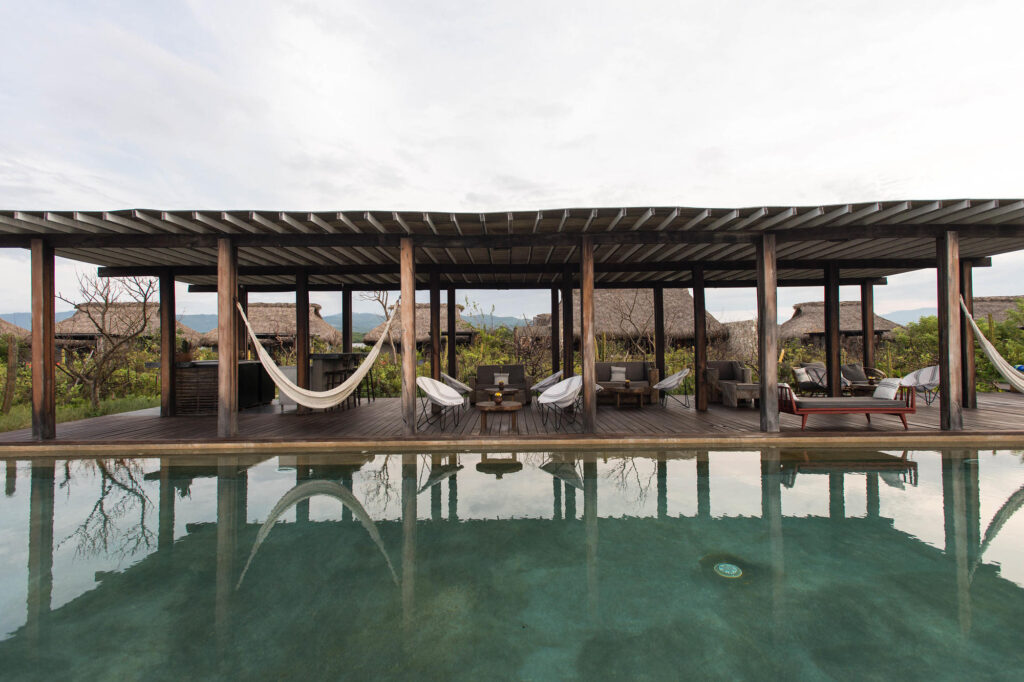
While Hotel Escondido is removed from the buzz of Puerto Escondido itself, it’s hard to argue with anything about this hotel. Incredibly private and tucked along a tranquil, natural stretch of beach, every detail about this property feels special. The beachfront infinity pool is exceptional, and bungalows come with plenty of bells and whistles (private plunge pools, anyone?). Open-air dining at Hotel Escondido is also highly recommended.
7. San Cristobal de las Casas: Indigenous Cultures and Stunning Nature
It’s a rare international tourist that makes it to Chiapas — and those that give this southern Mexico state a pass are missing out. That’s especially true for travelers who skip a visit to San Cristobal de las Casas, a designated Pueblo Magico, or Magic Town. And while that might sound mystical, the pleasures of San Cristobal are far more of this planet than the stars. You see, as the major city in the central highlands of Chiapas, San Cristobal serves as the nerve center of the region’s incredible indigenous communities who live in the mountain towns throughout the region.
On the surface, the beauty of San Cristobal de las Casas is its colonial heritage. You’ll find beautiful churches, cobblestone streets, and low-rise pastel buildings all around the compact and walkable historic center of town. Things are especially lively along Real de Guadalupe, the main road in town, where everyone seems to be and where you’ll find numerous restaurants and shops. Given the numerous indigenous villages all around San Cristobal — and their long history with textiles — it’s perhaps no surprise that the city is home to the Centro de Textiles del Mundo Maya, where you can see historic and modern indigenous textiles on display in their full glory. It’s certainly worth picking up an authentic locally produced textile from the shops in town as well. Head to one of the markets — like the Mercado Viejo — for a real taste of the local scene (and an astonishing array of produce, food, and — well — anything you can imagine, really.
If you’re willing to explore, though, you’ll find that much of the magic of San Cristobal stems from its deep indigenous roots and the surrounding natural beauty of the region. To experience the latter, you’ll find excursions offering mountain biking, horseback riding, and zip-lining all around. We also recommend checking out some of the more awe-inducing sights in the region. Boat rides into Sumidero Canyon are particularly spectacular, while tours that stop at El Chiflon Waterfalls and Lagunas de Montebello National Park are also worth the price. While the city center of San Cristobal serves as a commercial hub for the region’s indigenous communities, it’s also worth a visit to smaller towns like San Juan de Chamula and Zinacantan, where you’re far more likely to hear the indigenous Tzotzil language than Spanish.
8. Bacalar: Maybe the Next Tulum (But Hopefully Not)
If you’ve been paying attention, you might have heard of this laid-back little town that’s all the way down near Mexico’s border with Belize. You’ve also likely heard it compared to Tulum, about two hours up the coast. The comparisons aren’t inaccurate — in many ways the Bacalar of today resembles Tulum the way it once was. However, it’s completely unlike the see-and-be-seen foodie paradise of the Tulum of today. And we love it for that. Getting here requires some grit: It’s a four-hour drive from Cancun’s airport on a good day. However, the travel rewards are great.
Bacalar is most famous for the Lagoon of Seven Colors (Laguna de Siete Colores in Spanish) a sandy-bottomed series of shallow lagoons that creates the effect of seeing limitless shades of blue. It’s a major marine habitat, and perfect for swimming or snorkeling (just make sure you’re using an environmentally-friendly sunscreen). We also recommend grabbing a kayak (from your hotel or one of the many beach clubs) to paddle around the extensive shoreline. Otherwise, the pleasures here are simple: yoga, lounging around in hammocks and loungers, sampling local fare, and sipping drinks. And that’s the whole point. While some travelers are put off by the distance and the lack of much buzz, we think that makes Bacalar all the more special.
Our Bacalar Hotel Pick: Bacalar Lagoon Resort
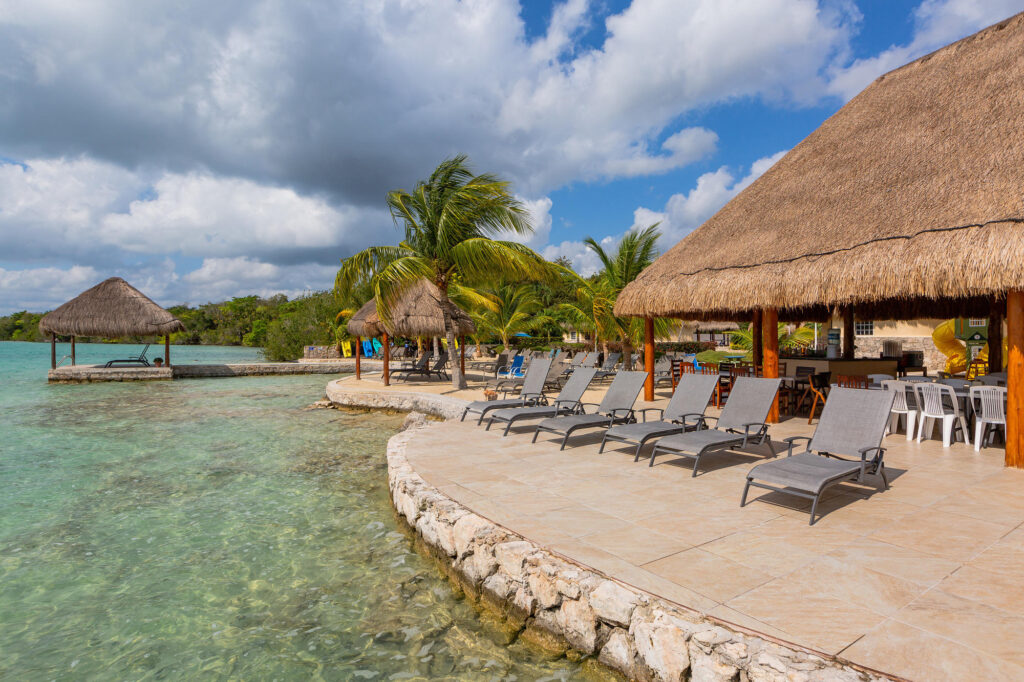
Situated on the shores of the Laguna de Siete Colores, the Bacalar Lagoon Resort perfectly matches its setting. With plenty of open-air spaces and room to view the tranquil waters offshore, this is precisely the kind of spot where you come to unwind.
9. Guadalajara: An Equally Cultural (and More Laid Back) Mexican Second City
Every country has one: That second city. And what that means is that there is a second larger, slightly less famous city that manages to steal the spotlight from the first city. In the case of the U.S., that first city is New York (with Los Angeles in second place), and in Mexico that first city is Mexico City. We happen to think that second cities make even better tourist destinations — they pack a lot of magic into a package with way less hype. And that perfectly exemplifies Mexico’s second city of Guadalajara.
As the capital of Jalisco, the city of course embraces its local heritage, most notably in the form of tequila (for which Jalisco is famous) and mariachi music (which was reportedly born in Jalisco). However, the cultural roots fo Guadalajara are far more extensive than this. For starters, the historic city center is home to an incredible collection of baroque churches and architecture that give Mexico City’s Centro a run for its money. Historic architecture aside, the city hosts one of the world’s largest book festivals every year, and — of course — celebrates its mariachi history with a week-long Mariachi Festival in September.
If you’re in search of fine art, you’ll find numerous murals by Jose Clemente Orozco in Guadalajara. His famous “Allegory of The Man of Fire” cupola mural is at the UNESCO-designated Hospicio Cabañas (also known as the Instituto Cultural Cabanas). The contemporary art scene is also on the rise, with more and more galleries opening every year. Accompanying that is an explosion of foodie dining destinations throughout the city center. If Guadalajara is too much for you even with its comparably laid-back pace, head out of town to Tlaquepaque, a 20-minute drive away and a popular day-trip. Tours and tequila tastings are a great way to do this.
Our Guadalajara Hotel Pick: NH Collection Guadalajara Centro Historico

If you want to base yourself smack in the center of Guadalajara — and you should in this supremely walkable city — the NH Collection Guadalajara Centro Historico is your pick. Views can be incredible throughout the hotel — including its terrace restaurant — and rooms are fresh and simple.
You’ll Also Like:
- The 10 Best Magic Towns in Mexico
- The Most Charming Hotels in Mexico
- Playa del Carmen vs. Cancun: Which Mexican Destination is Best For You?
All products are independently selected by our writers and editors. If you buy something through our links, Oyster may earn an affiliate commission.
